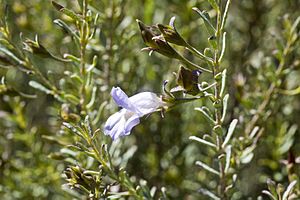Blistered eremophila facts for kids
Quick facts for kids Blistered eremophila |
|
|---|---|
 |
|
| Scientific classification | |
| Genus: |
Eremophila (plant)
|
| Species: |
pustulata
|
The Eremophila pustulata, also known as the blistered eremophila, is a special flowering plant. It belongs to the figwort family, called Scrophulariaceae. This plant is endemic to Western Australia, which means it naturally grows only there. It's an upright shrub with thick, bumpy leaves and pretty purple, lilac, violet, or white flowers.
Contents
What Does It Look Like?
The Blistered Eremophila is an upright shrub. It usually grows to be about 0.5 to 1.5 meters (1.6 to 4.9 feet) tall. When the branches are young, they are yellowish-green or purplish. As they get older, they become reddish-brown and woody.
These branches have small, raised, warty bumps. They are also glabrous, which means they are smooth and don't have any hairs. The leaves grow in pairs on the branches. They are thick and have a rounded shape underneath.
Most leaves are about 5.5 to 9 millimeters (0.2 to 0.4 inches) long. They are also 1 to 3 millimeters (0.04 to 0.1 inches) wide. The leaves are smooth and have raised glands. They are shaped like an egg or a spear, with the narrower end at the base.
The flowers grow one by one where the leaves meet the stem. They sit on hairy stalks that are 2 to 3 millimeters (0.08 to 0.1 inches) long. Each flower has 5 green, hairy sepals. Sepals are like small leaves that protect the flower bud. These sepals are egg-shaped and about 2 to 3 millimeters long.
The petals are 9.5 to 13 millimeters (0.4 to 0.5 inches) long. They are joined together at the bottom to form a tube. This petal tube can be lilac, purple, blue, or sometimes white. Inside the tube, you might see faint purple spots. The 4 stamens, which are the male parts of the flower, are completely hidden inside the petal tube.
This plant flowers from April to December. After the flowers, it grows fruits. These fruits are oval or almost round. They are smooth and reddish-brown to blackish-brown. They are a type of drupe, which means they have a fleshy outside and a hard pit inside, like a peach.
How It Got Its Name
This plant was first officially described by a scientist named Spencer Le Marchant Moore in 1905. He published his description in a science journal called Journal of Botany, British and Foreign.
The plant's scientific name, pustulata, comes from a Latin word. The Latin word pustula means "pimple," "bubble," or "blister." This name was chosen because of the noticeable wart-like bumps on the branches and the underside of the leaves. It really looks like it has tiny blisters!
Where It Grows
The Blistered Eremophila is very common around the area of Kalgoorlie in Western Australia. It grows in specific natural areas called the Coolgardie and Murchison biogeographic regions.
You can find it growing in sandy-loam or clay soils. It often grows in greenstone hills and flat plains.
Is It Protected?
The Western Australian Government's Department of Parks and Wildlife has looked at the Eremophila pustulata. They have classified it as "not threatened." This means there are plenty of these plants, and they are not currently at risk of disappearing.
Growing This Plant
This eremophila is a very strong and attractive shrub. Some of these plants have been grown in gardens for over 25 years! You can grow new plants from seeds or from cuttings. Cuttings are small pieces of the plant that can grow roots.
It grows well in many different types of soil, even clay. It likes full sun or partial shade. It can also handle both dry conditions (drought) and cold temperatures (frost). This makes it a very hardy plant for gardens.

